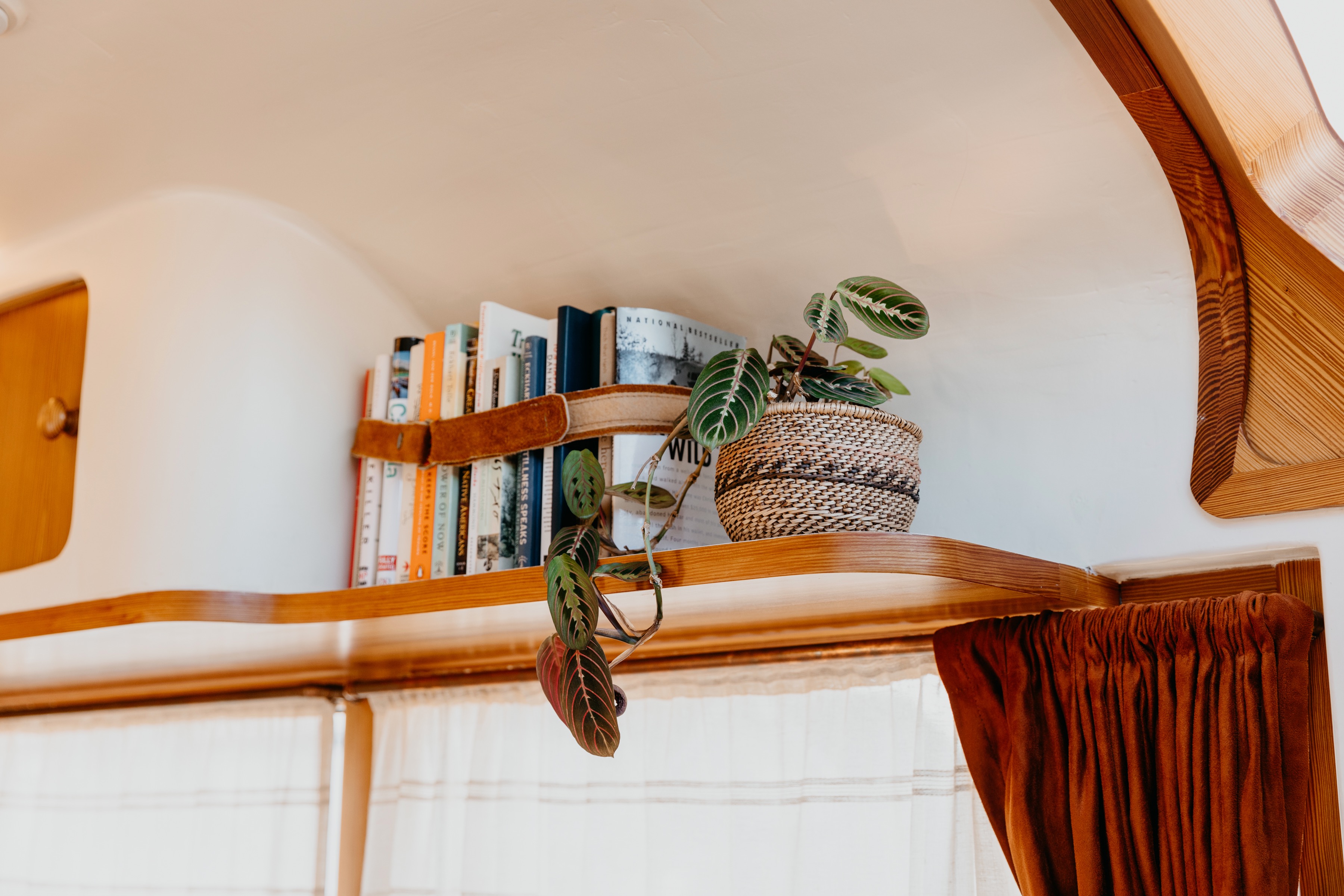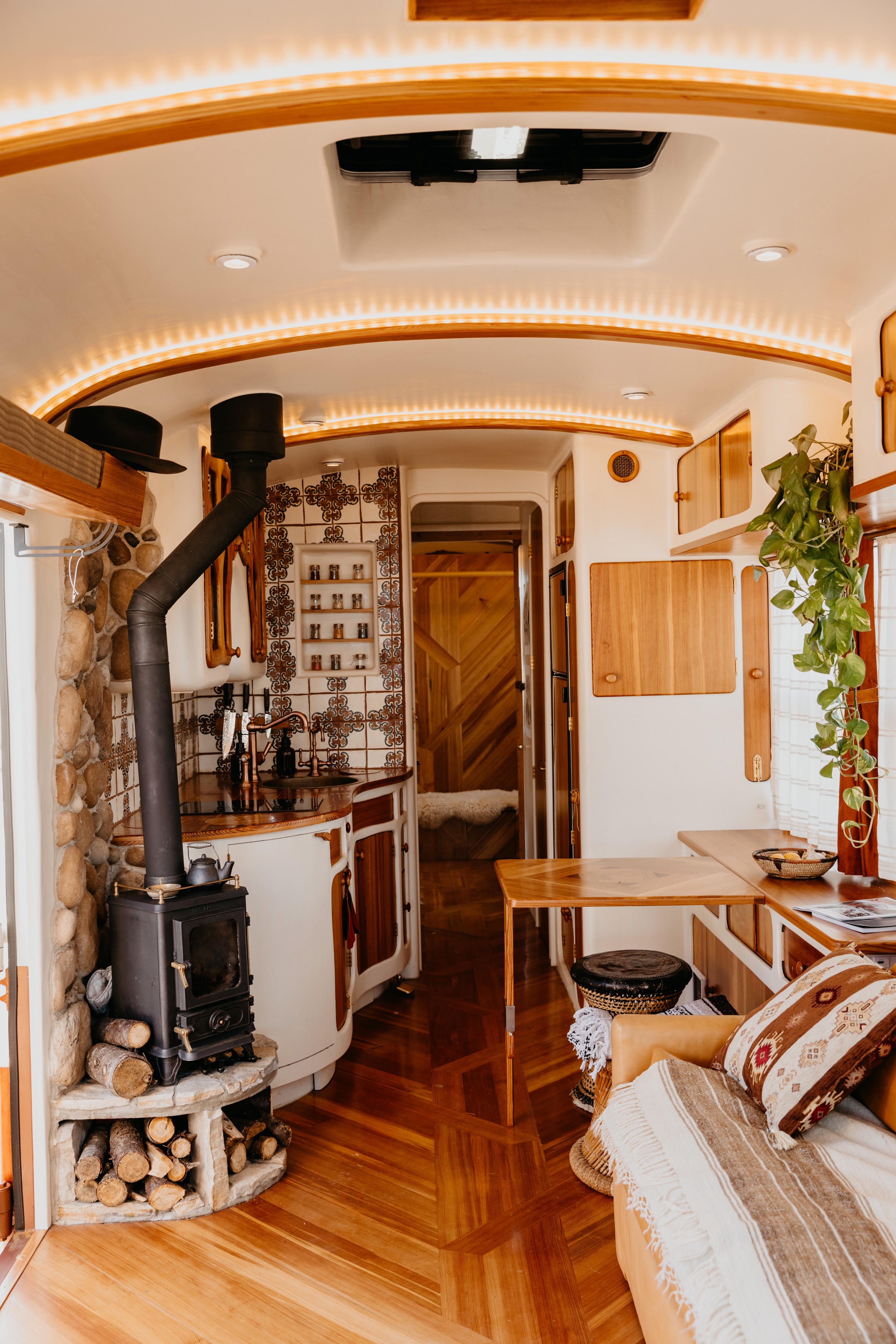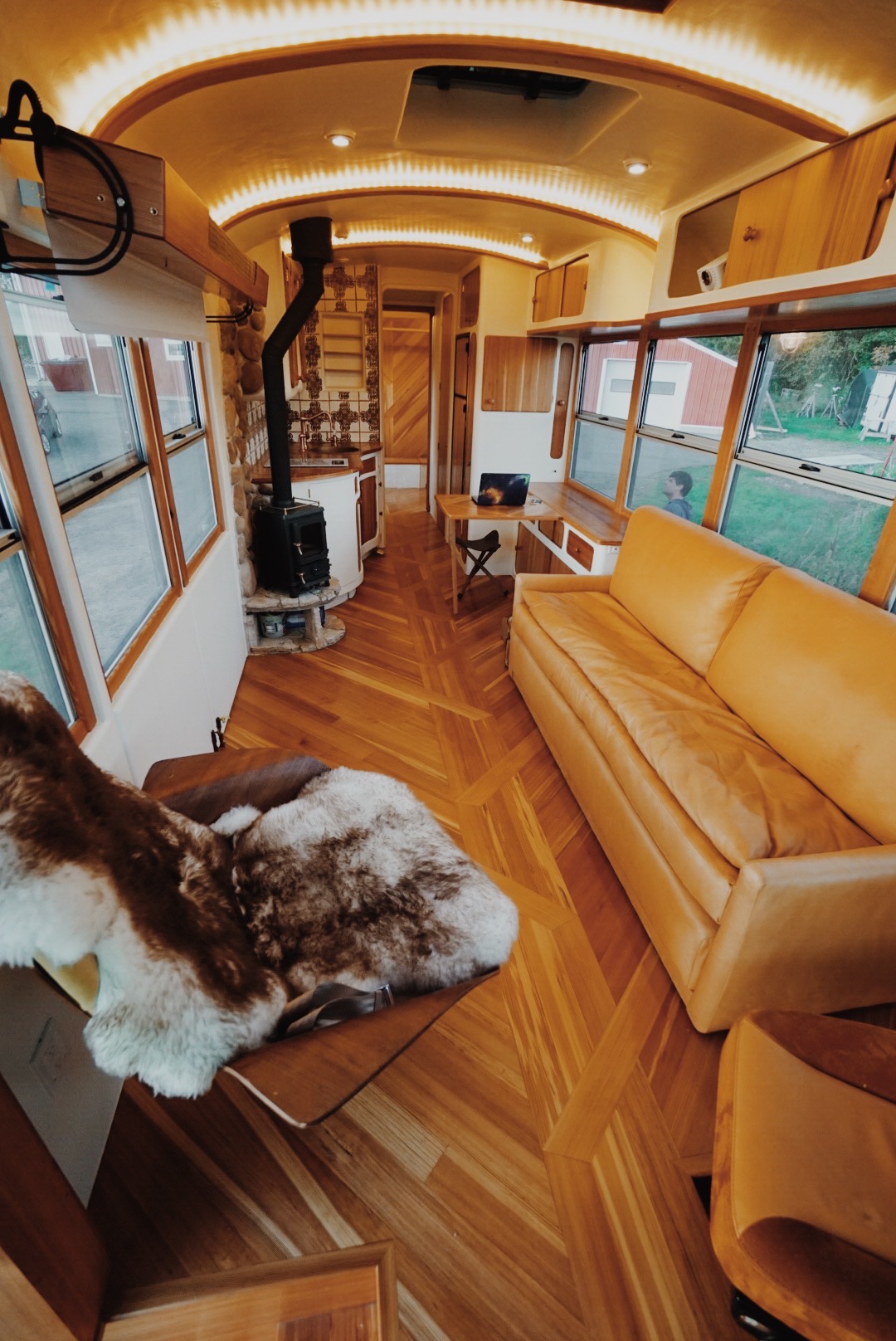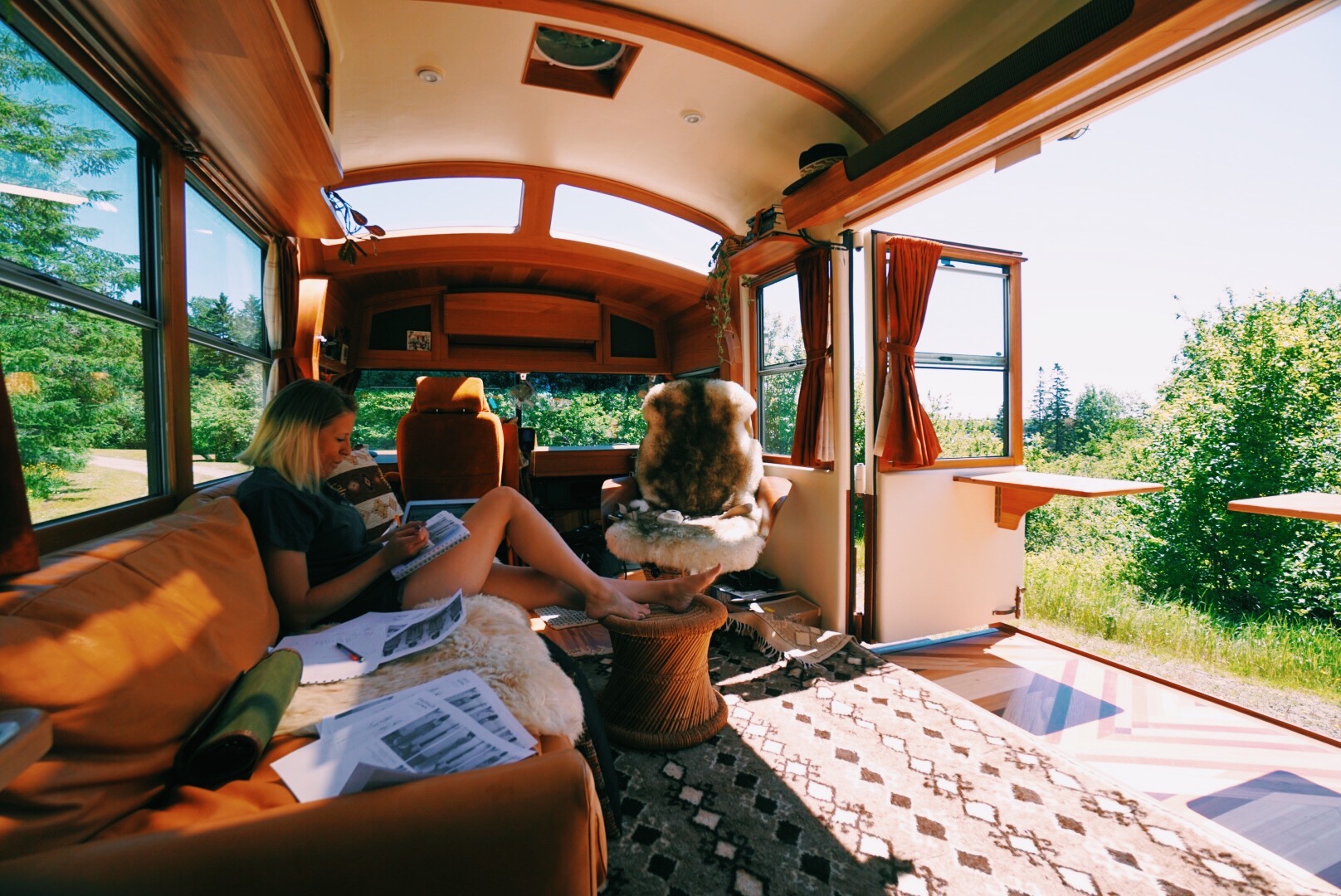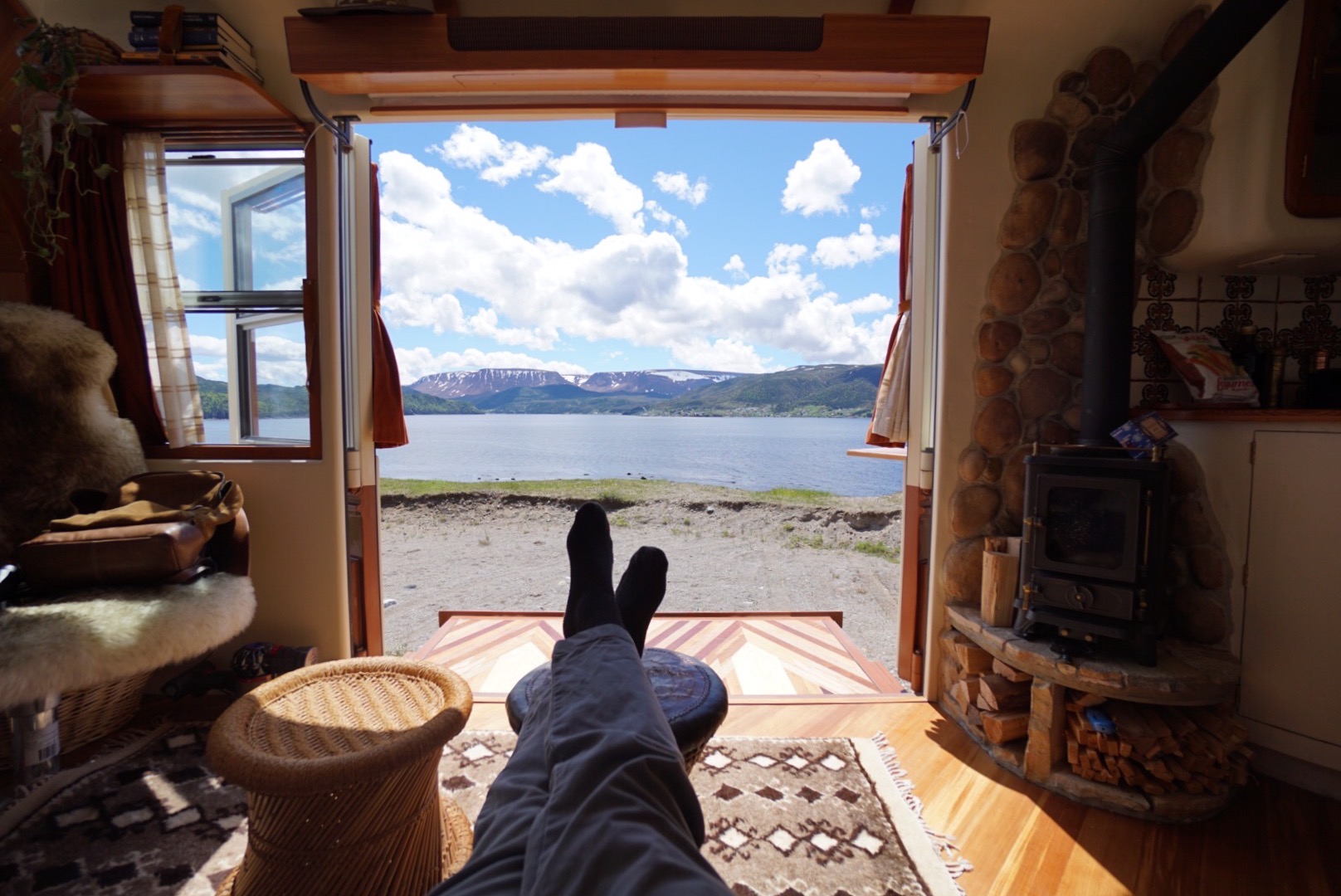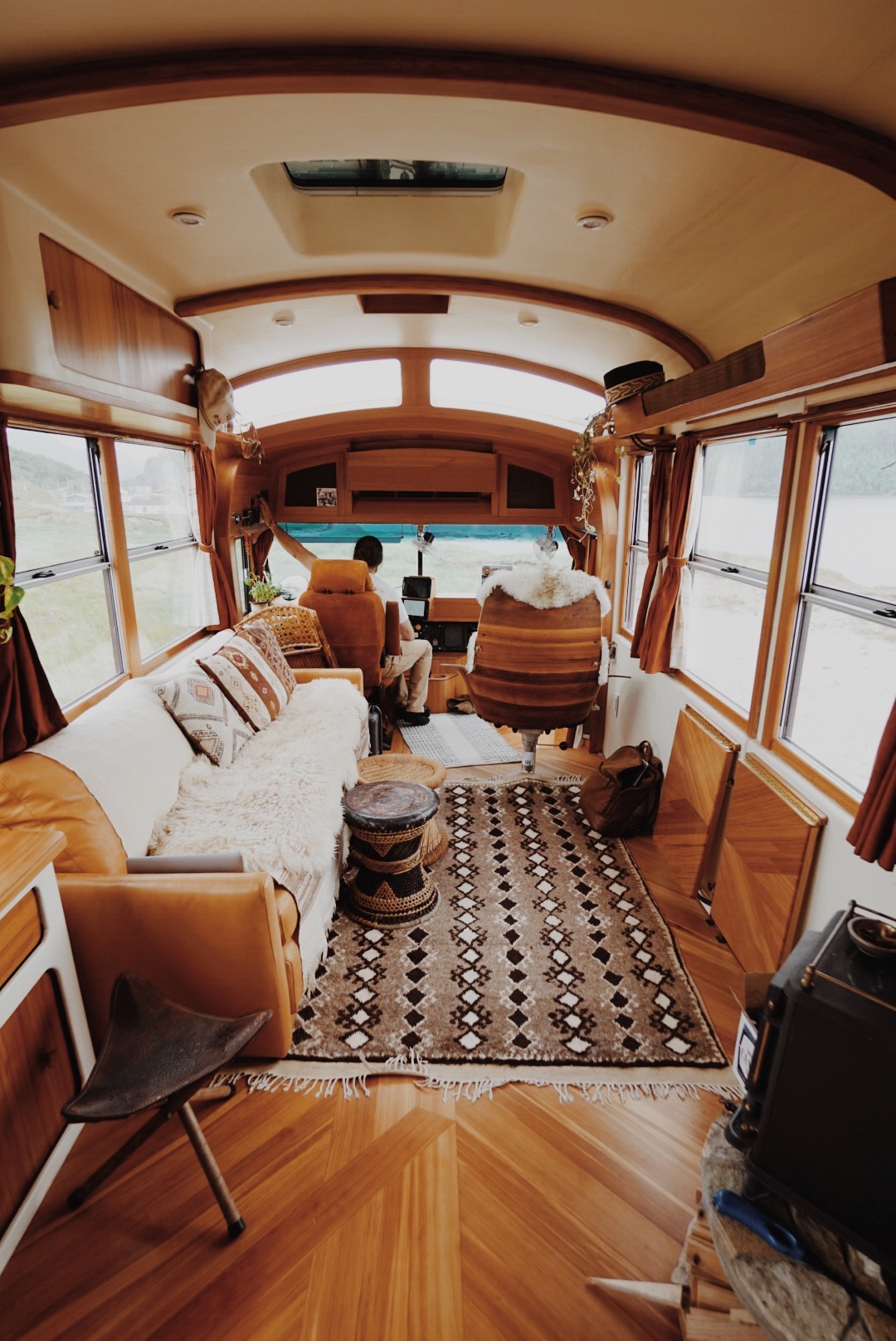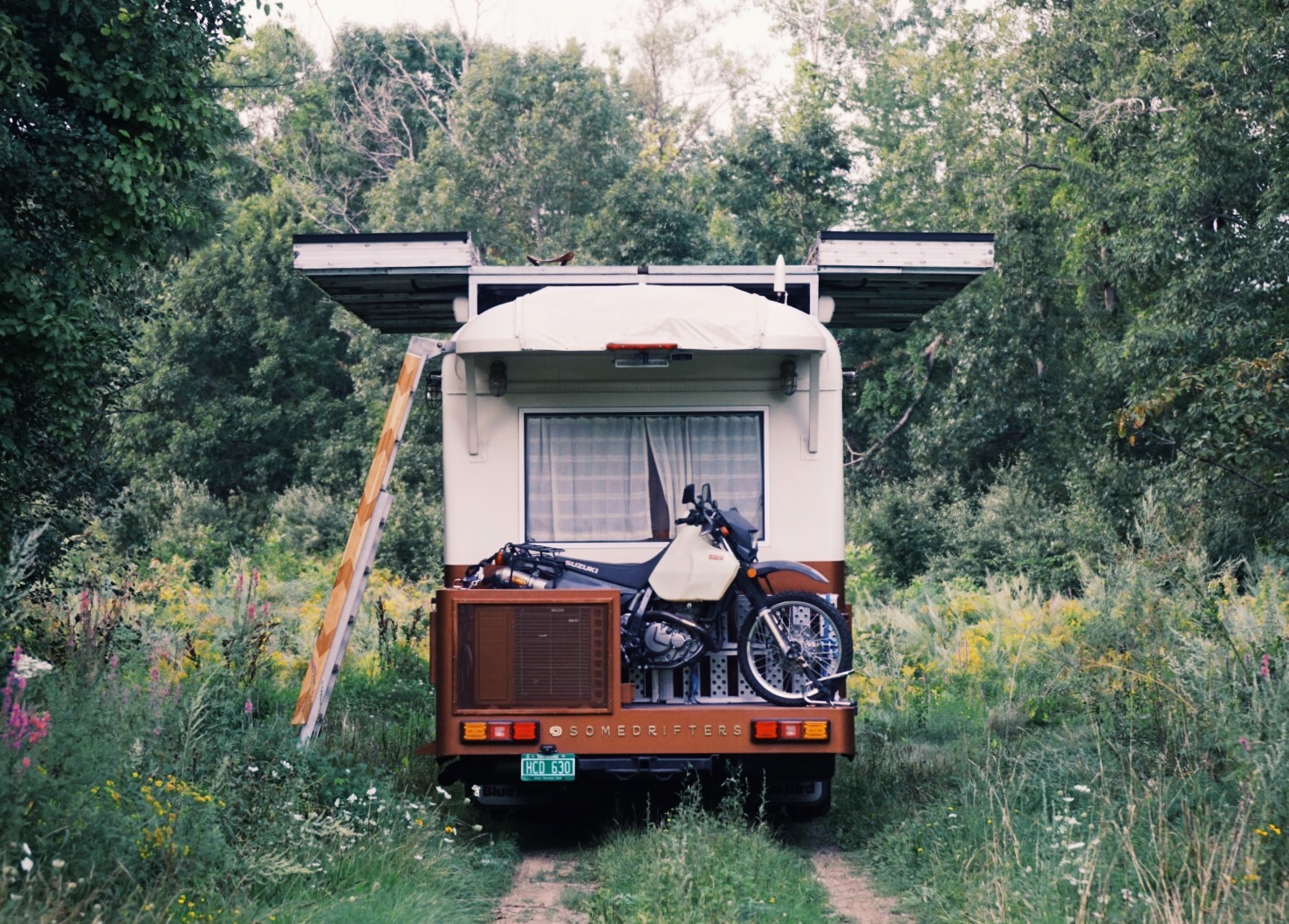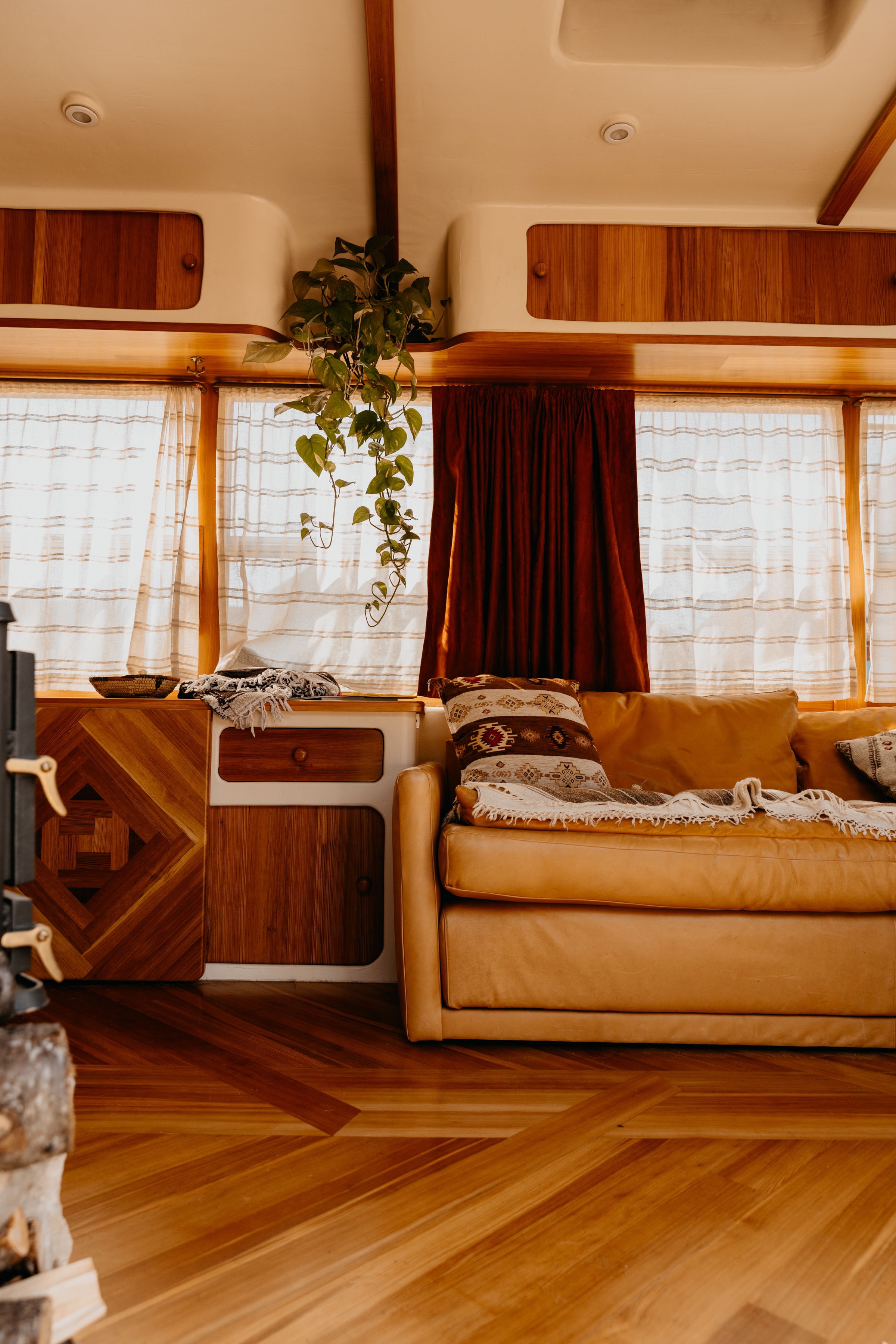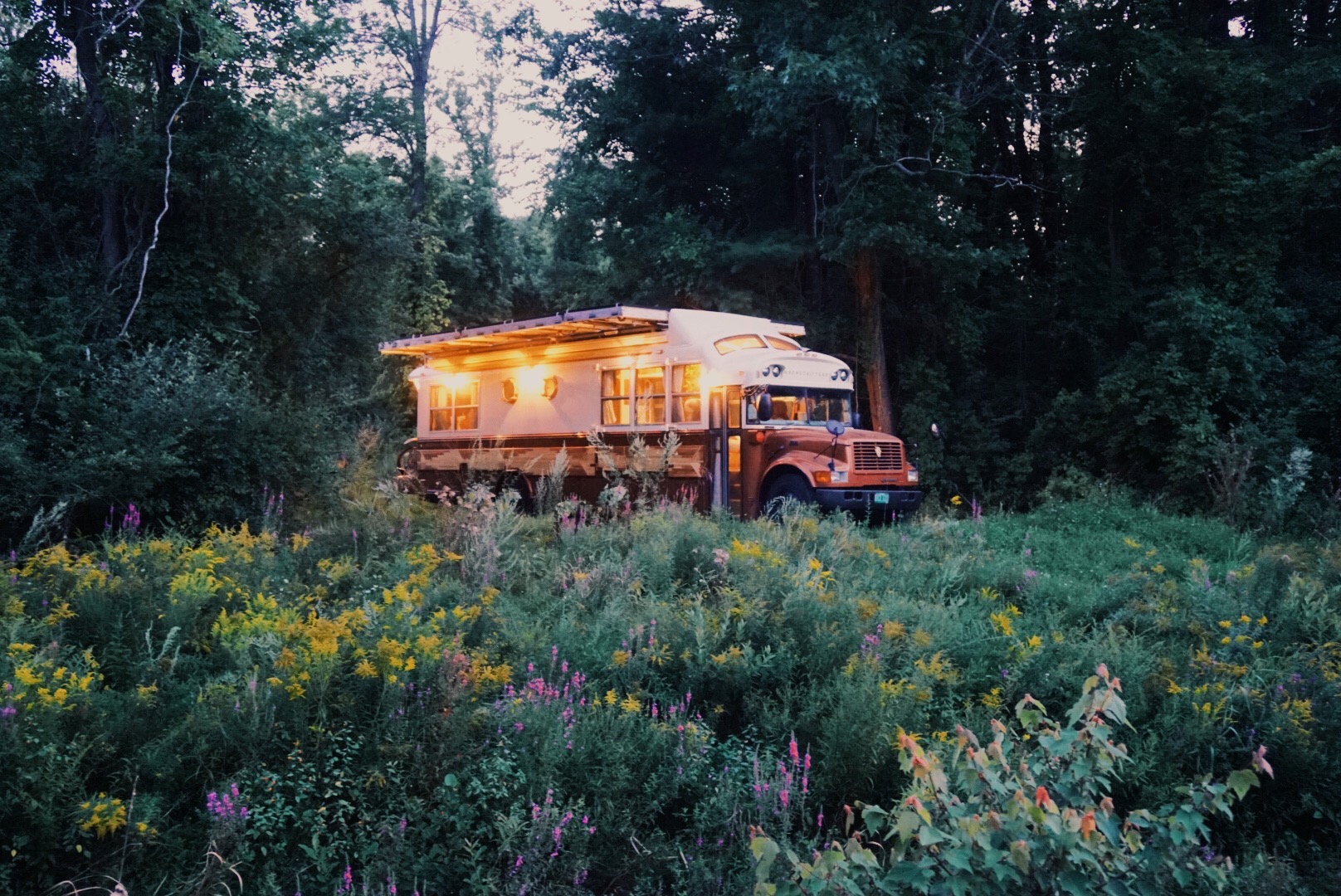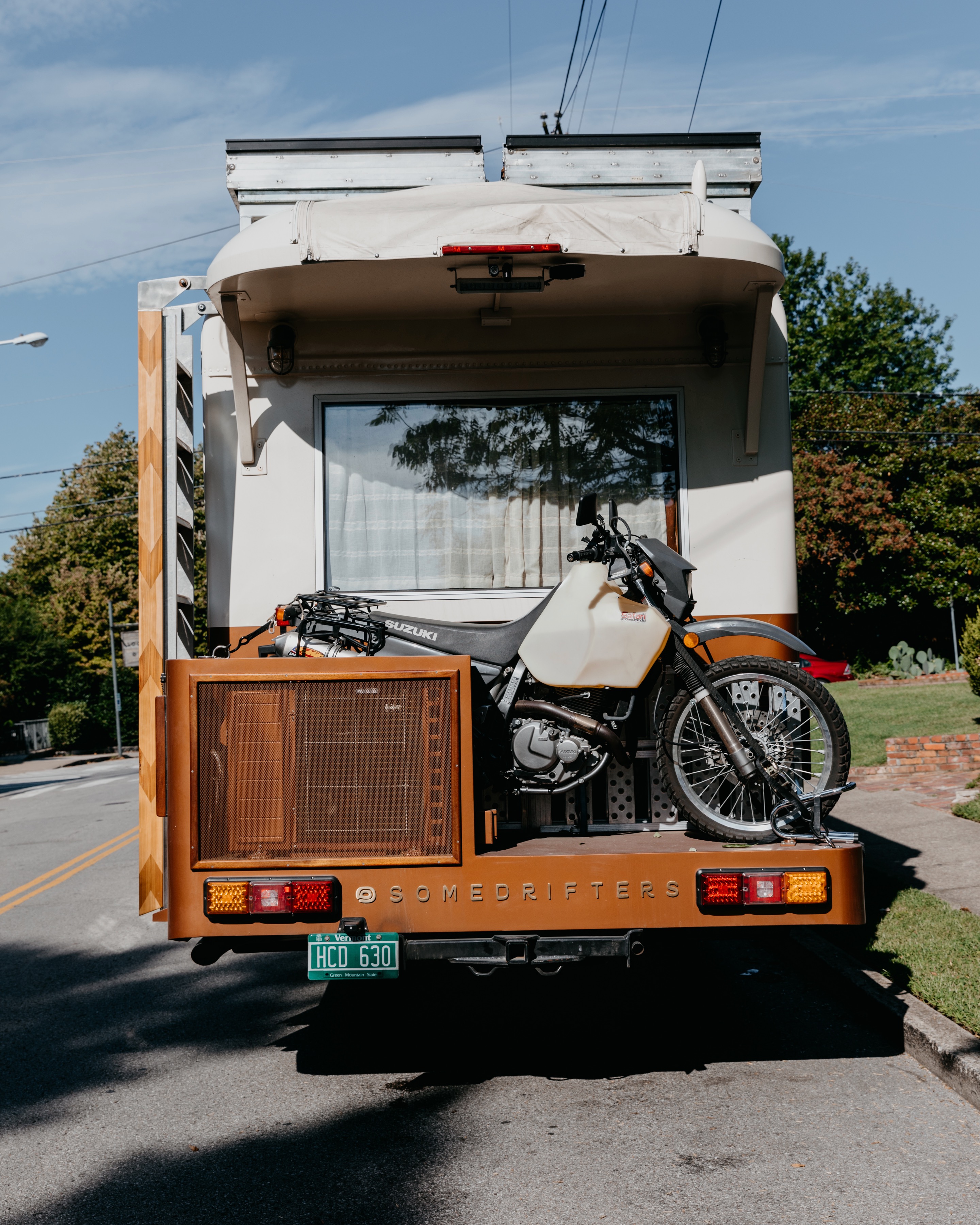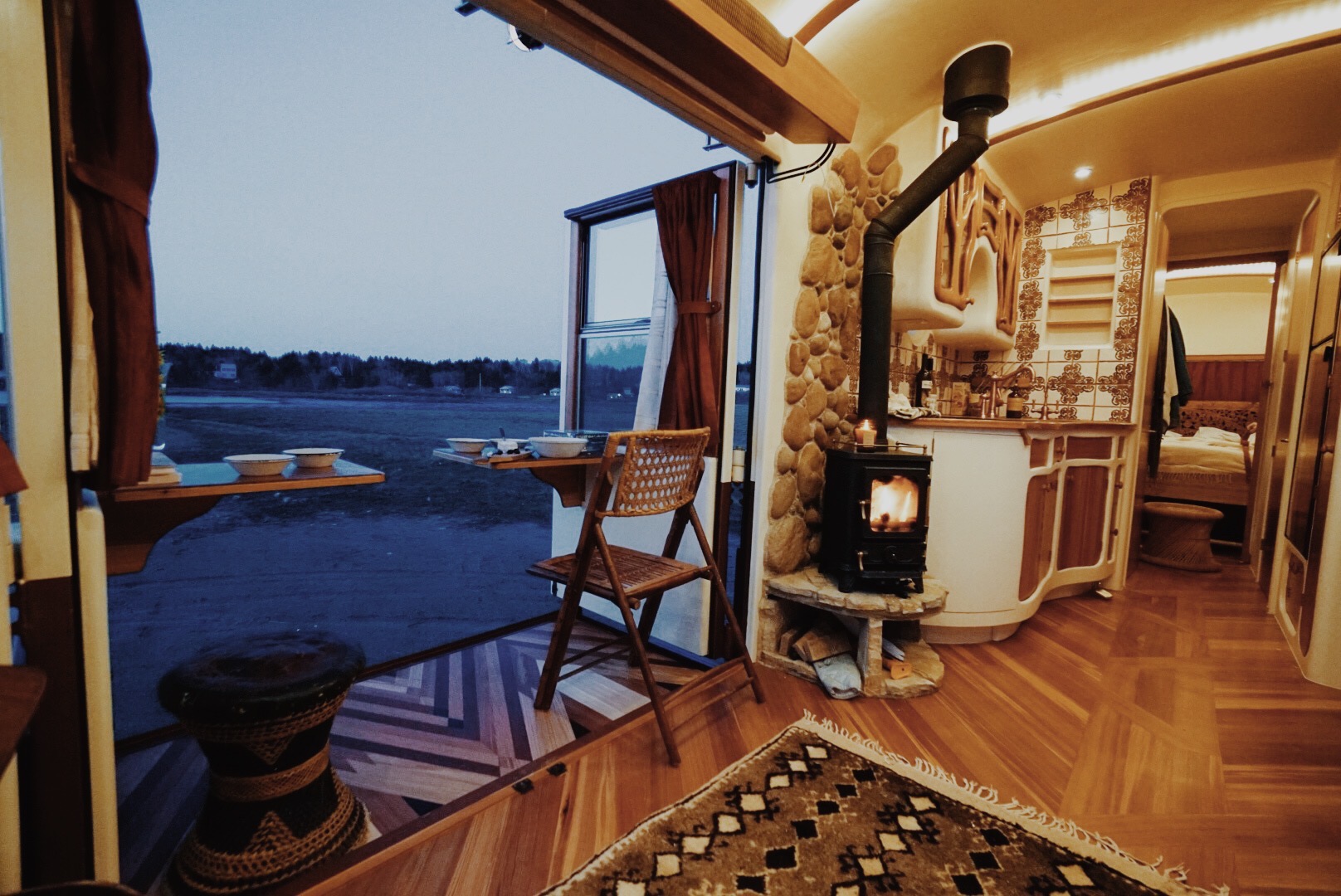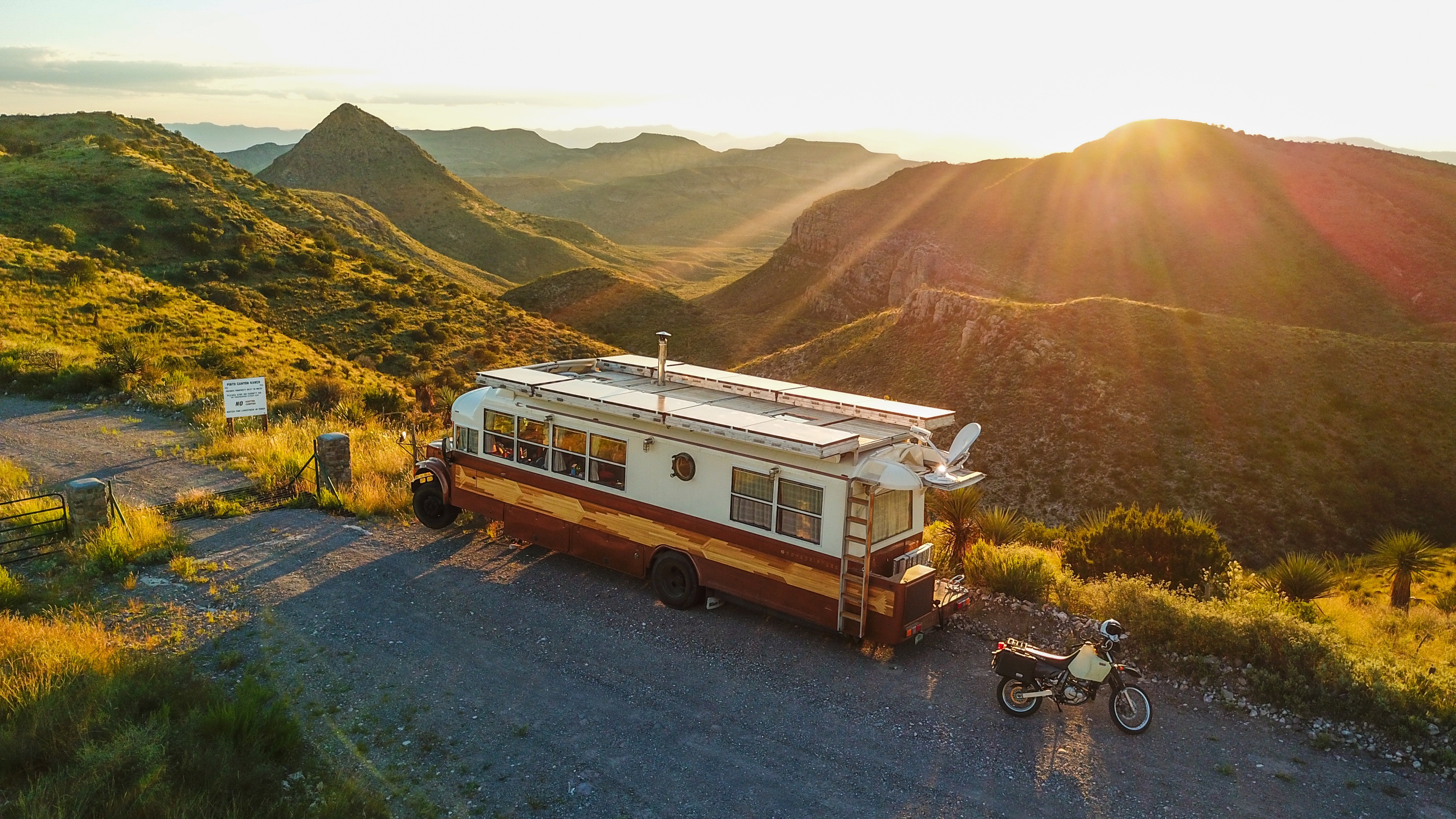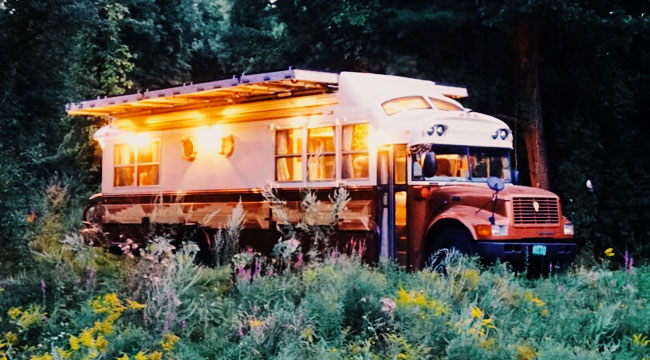
There’s a definite appeal to small, meticulously designed spaces like tiny homes, treehouses, and vans. Freud would likely link it to a desire to return to the womb, and…. sure, maybe that’s it. Or it could be that they look cool and feel freeing. Whatever the case, we get stoked when we find spaces that are both cozy and meticulously designed. And holy hell does the schoolie in this post ever fit the bill.
Jeffrey Osborne and partner Brit Castaños-Osborne have lived in a number of big cities — New York City and San Francisco among them — and consider themselves traveling spirits who are highly connected to nature. They wanted to be able to spend more time outdoors without sacrificing their businesses, and a school bus conversion was the perfect residence to meet all of their needs. But it did take a little coaxing from Jeffrey to get Brit fully on board.
The owner of a bohemian wedding dress company called Daughters of Simone, Brit was uncertain about living in a school bus, so Jeffrey had to be able to offer her a design that could serve as a living quarters and a business. After a few weeks of discussion and the development of a plan that included a fitting room for her clients, Brit warmed to the idea. Once Jeffrey got the green light, it was all systems go.
Their skoolie was completed this year, and we have literally never seen a more perfectly handled conversion. We can’t stop cruising their Instagram and staring in wonder at the organic layout and intricate woodwork. So you can imagine that we had a lot of questions for Osborne when he sat down with us. Read on to learn about the design process and to check out beautiful pics.
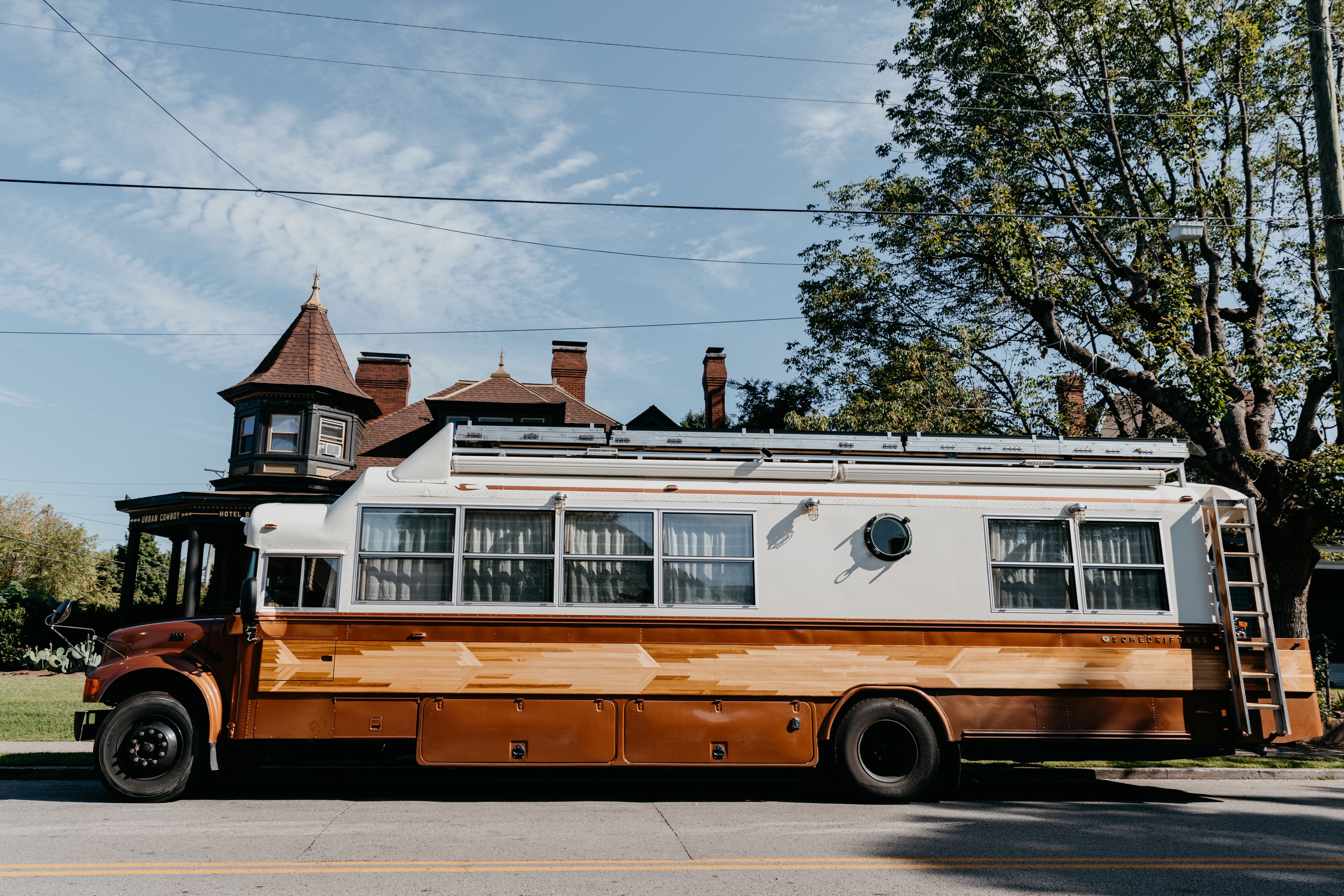
You were married before you got on the bus?
We were engaged when I came up with the idea. It’s been about three years from when I actually brought it to completion. It was two and a half years to build out from the day we started chopping it up and actually doing it. It’s been quite a stretch of time.
Why did you go bus over van?
That’s mainly for size. I imagined fully living in this vehicle in a way that’s comfortable with a shower and bathroom and being able to have guests come to stay with us. Also, this fits in with my wife’s business model. That was part of the plan. So, I set it up so that you could fit about ten people sitting in the living room area, and the backroom converts to a fitting room with a high clothes rack to hang dresses and a full-length mirror and all that.
Also, school buses are extremely rugged. Vans are too. I’m not trying to take away from vans. Those are awesome. But, as opposed to an RV or a more traditional bus, they’re lower to the ground. School buses are built for dirt roads and rugged terrain more so than almost any other big vehicle like them.
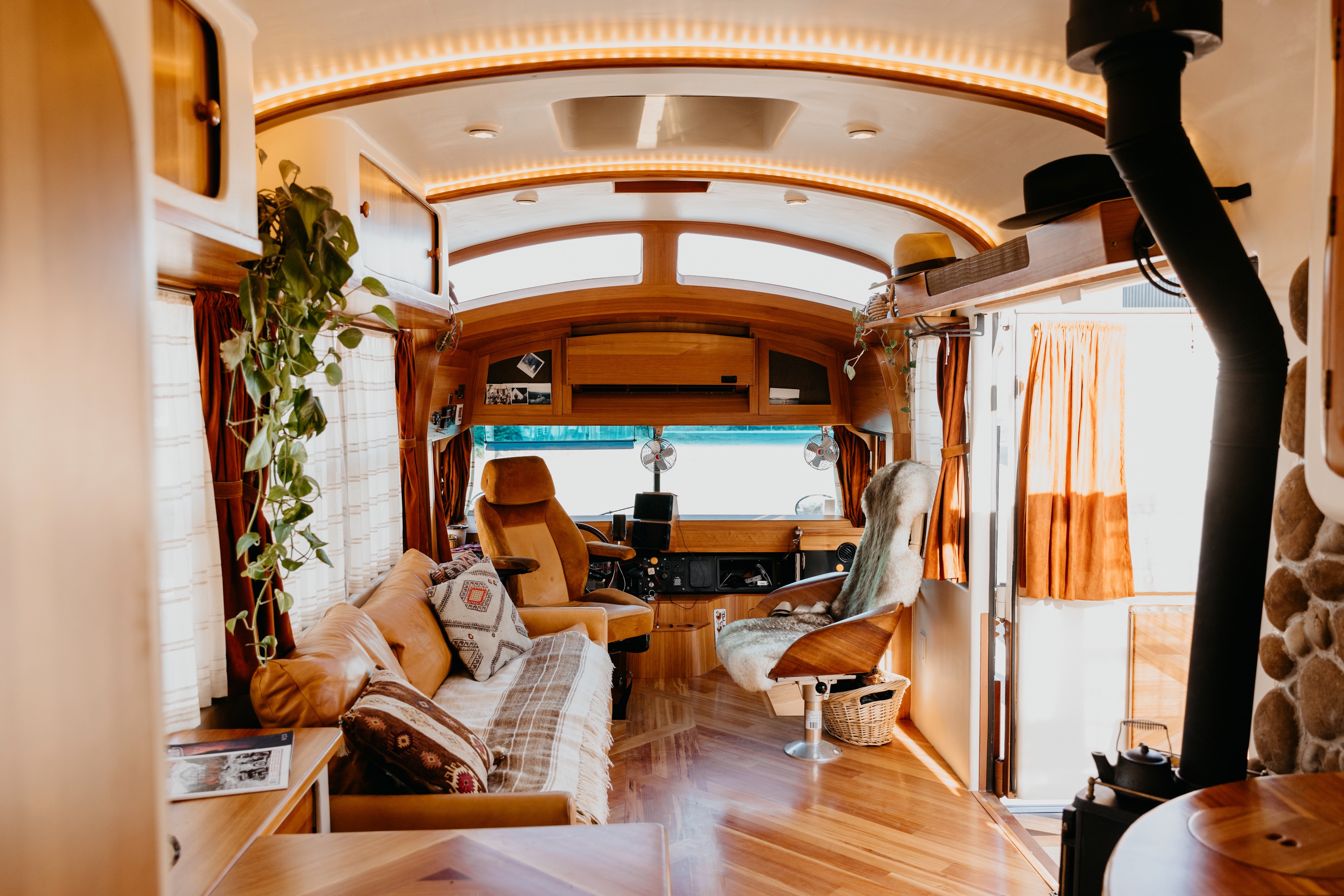
What about the parking situation?
That’s super interesting. Sometimes in cities, we’ve come in late, and we’ll park in a neighborhood. The main idea, the vision, the dream behind the bus is to park it in the absolute middle of nowhere. I envision northern Arizona, southern Utah, or New Mexico and parking on public land. It’s not needing anything for weeks at a time. That’s kind of the vision that drove the entire design of this bus. It’s built to be completely off-grid, to not need plugins and hookups and all that. That’s why I have so much solar and water storage and things like that.
We usually park it randomly outside of town, as far as we can get. It depends on where we’re visiting. Everywhere is very different, so it can really vary. The other night we slept in an abandoned golf course parking lot, which was awesome. It was in Nashville, and we could still get to town in 15 minutes. So it was beautiful and quiet and also close to town. Then one night we’re on the road, and we have to pull over and just park on a dirt road just off the main road. So, it depends.
Vans are smaller, so I would assume that they would offer more options. I don’t know that you can pull your school bus up in a Wal-Mart parking lot, but maybe.
Yeah, we can. We’ve done Cracker Barrel a few times. It’s just a smaller scale without the big lights at Wal-Mart and all that. But that’s just when we’re on the road and we hammer a lot of miles and don’t have time to find a perfect spot. Also, you’re just gonna be there for sleeping. We’ll do those things if we have to, but the vision is to spend a week or two at a time in one location and have it be somewhere really pretty.
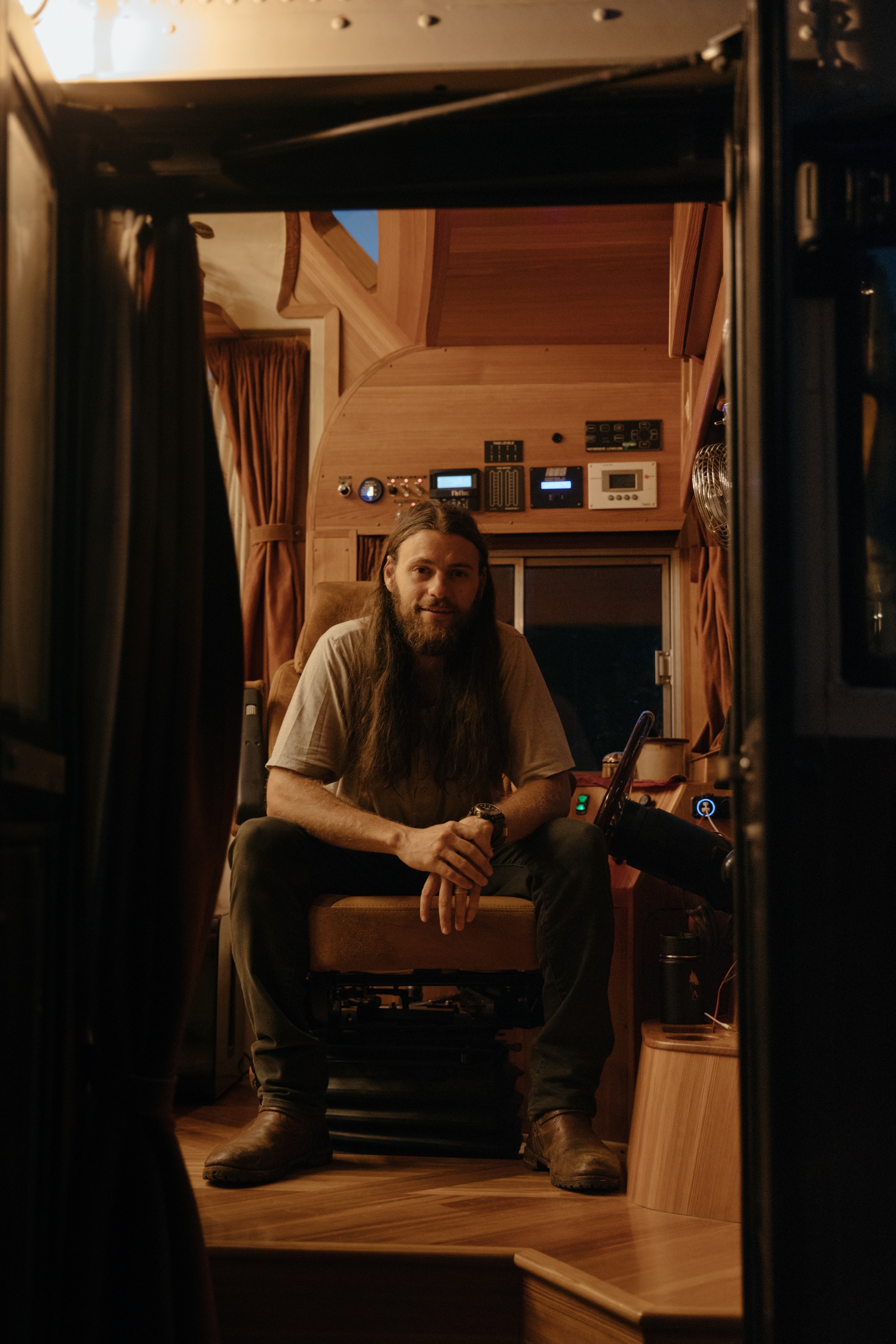
You finished the bus very recently, right?
I just finished it in June, and we did a six-week trip up in Newfoundland and back. The goal was to shake it down and find all the weak links in the design. Some things fell off and some things broke and yadda, yadda. Then we finally got it back. It was built at a shipyard in coastal Maine, so we did a big week there and back through Nova Scotia, and then we ended up taking a ferry back into Portland, Maine. It was this huge loop. That was our first trip, and then we dropped it off for another few weeks to fix those issues. And then we were off. The bus is in west Texas at the moment.
What prompted the full remodel?
Well, starting with a bus. The advantage of buying a school bus (and this applies to the cargo vans that people use, too) is that they’re just an empty shell, and you can make them be whatever you want. That’s the attraction for me. Plus, they’re very inexpensive. They’re under $20,000 for sure and often down into the thousands of dollars. But, they’re just an empty metal shell essentially. And, now you can do whatever you want, instead of buying an RV that’s already built out in a certain style. That was the attraction to me. I was buying an off-road, rugged kind of frame, and then I could just build out whatever I could imagine into that.
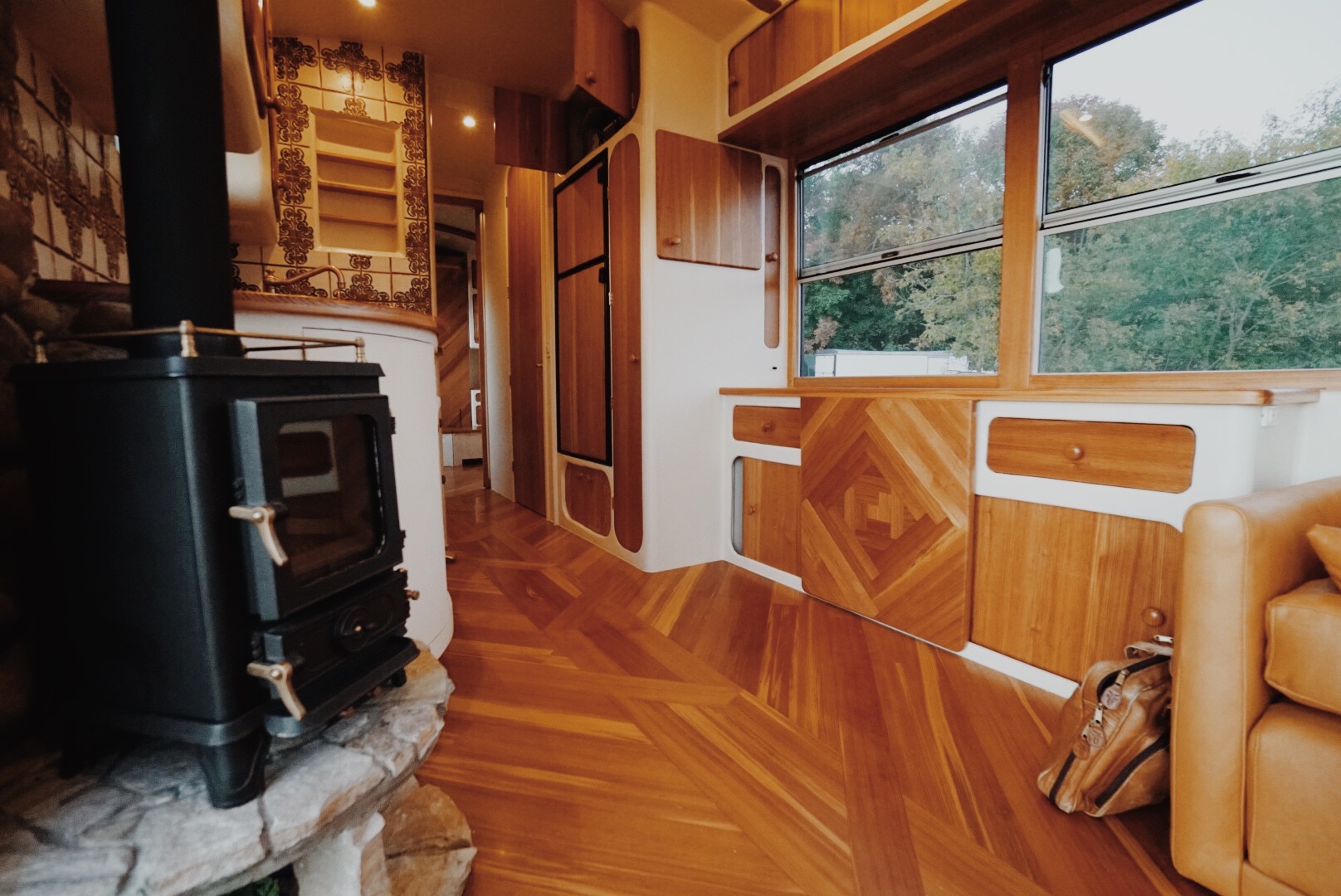
How involved were you in the design?
I designed it and managed the construction of it. I also had someone help me with some of the wood inlays. 1767 Design out of Nashville helped design the wood inlays in the floor and on the exterior, things like that. But, when it comes to just where things went and the floor plan and all the design elements of it, that was all just me and a pad of paper and many hours.
I think it’s one of the most cohesive, beautiful skoolie designs I’ve ever seen. It’s gorgeous! Is that what you always planned it to look like?
I bought the bus in Denver because out west they have fewer salted roads. They have bigger mountains, so they buy school buses that have bigger engines and bigger transmissions. In the end, they’re usually in better shape ’cause they’re not as damaged by the rust. So, I bought it out there. Then we took the seats out and I did a cross-country trip. We did a mobile mural project and had people paint on it.
We just left it an empty bus for four weeks out on the road. And, at that time, I got to live in it. It wasn’t built out at all. There was nothing in it. But, at that time I was able to imagine, “Okay, what are the most important elements to me?” The first thing was laying it out. I wanted the walls to be as far back as possible, so when you walk in, it’s very open.
It started down at the bones and built out from there over the next three months. Designing it and then coming out to the finished product is like, “Okay, what’s the wall made of?” Those kinds of elements start driving the construction process. But, it was just time. I even lived in it for a little while. I live in Bushwick, Brooklyn part of the time. I parked it in our neighborhood out here, and I’d go sit there. I set up my laptop and had little cut-outs of on grid paper. I cut out different sofas and different shapes and designed it like that.
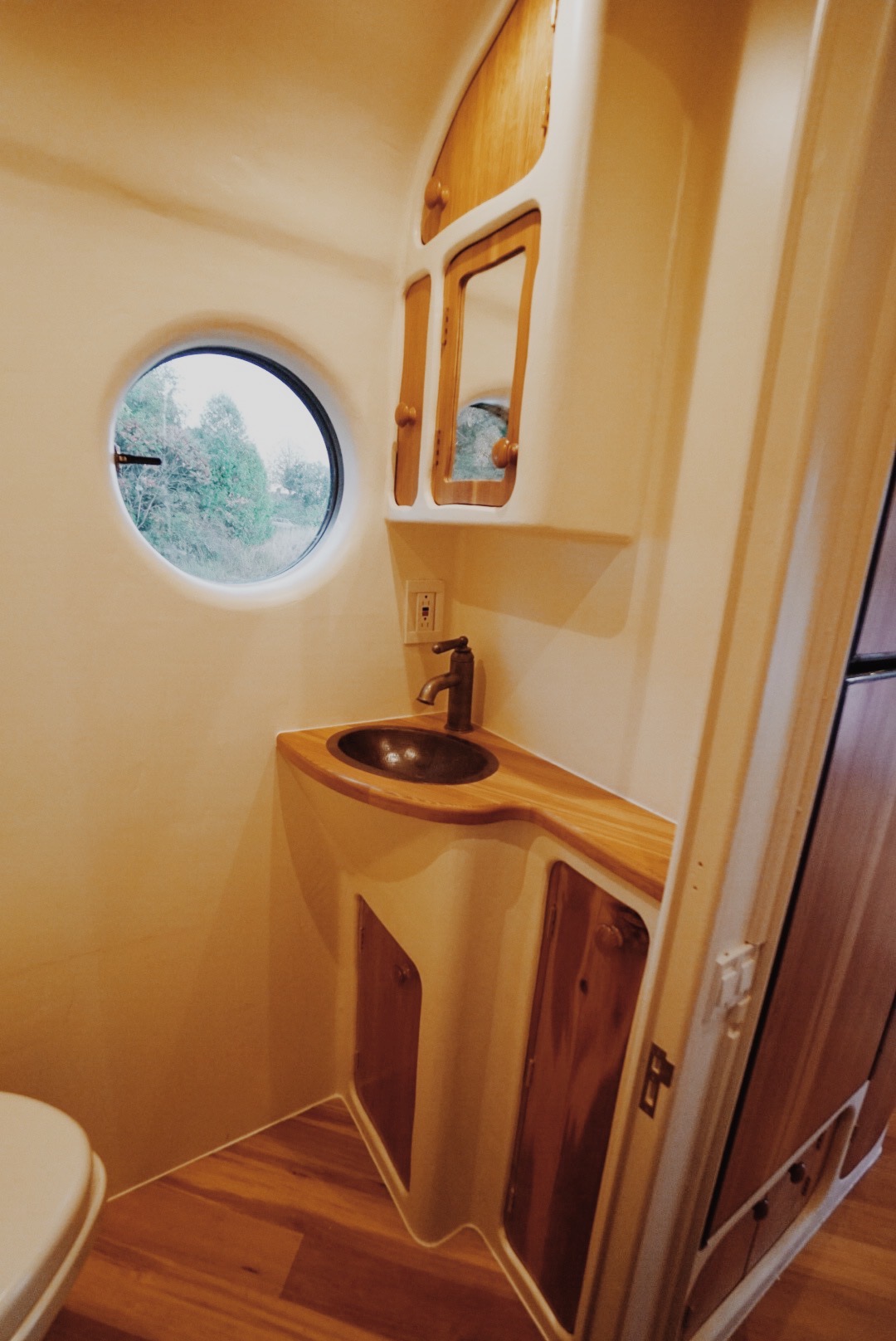
How long did the actual construction take?
We started construction in November 2015. If you go back into our feed, you’ll see taking the windows out. The project started in Bed-Stuy, Brooklyn with motorcycle builder Tim Harney. I had the floor plan and the system, which was another big element to this build. It’s extremely complex behind the pretty shell you see. It has a giant lithium battery and an incredible amount of solar. I’d never seen this amount of solar on any moving vehicle before. And the solar panels also tilt, so there’s a lot of complex elements to the system. All that stuff is behind all of this. You never see it, but in the end, you’ve gotta start there because it drives how you build it. You start at the systems, and you build out to the finish.
We spent four months doing that in Brooklyn, and then we got into the systems and installation. It got really complicated, and so I ended up moving it to a shipyard in Maine. There were guys that were really familiar with those exact off-grid systems ‘cause boats are the ultimate off-grid. They’re made for saltwater and rough water and all that, so these guys really knew how to secure things and how to wire things for rough conditions. They also knew how to build something to be completely self-sufficient. If a boat goes out, there’s no support out there. With an RV, you just go park in an RV park most the time.
After putting a lot of time into you’re almost obligated to live there until you die, right?
I will die in that bus.
You put so much work into it!
It’s one of those things where now that it’s done, it’s been such a journey. I think it took about six months from when we started the construction to actually being like, “Okay. Here’s the finished design. Here’s what the interior walls are going to be made of. Here’s where the openings are. Here’s what the wood is gonna be like. Here’s all that.” So, six months in it was like, “This is what we need to build.” And, it took two more years from that point to actually finish it to that spec.
The whole time was just solving incredible problems all the time because no one’s ever done this. No one’s ever built a bus to look like this on the inside, for example. And no one’s ever built it to have all this solar and all this water storage. It was a lot of problem-solving for a couple of years, which sometimes is really exciting, but then sometimes you just get bogged down with these things that seem so trivial. It’s like, “Oh man, how is that so hard?” We’re fabricating things and trying to make solutions to things that we’re figuring out as we go.
It was a big build up to when we finally got to live in it. Now that it’s done, it’s like, “Whoa. This really is the dream I originally had in my head. It looks just like it. Even better than I could have imagined.” It’s like, “Yeah I want to live in this thing forever. It’s incredible.” Even my wife was a little skeptical; she was like, “Are we gonna live in this full time for however long?” So, we kept our apartment in Brooklyn just in case for the last few months to test it out first. I’m happy to say now I’m back here in Brooklyn, actually moving out. We’re fully committed, and this is our full-time home for the foreseeable future.
I don’t know if I will die in that bus, but maybe I’d like to be taken away in it somewhere.
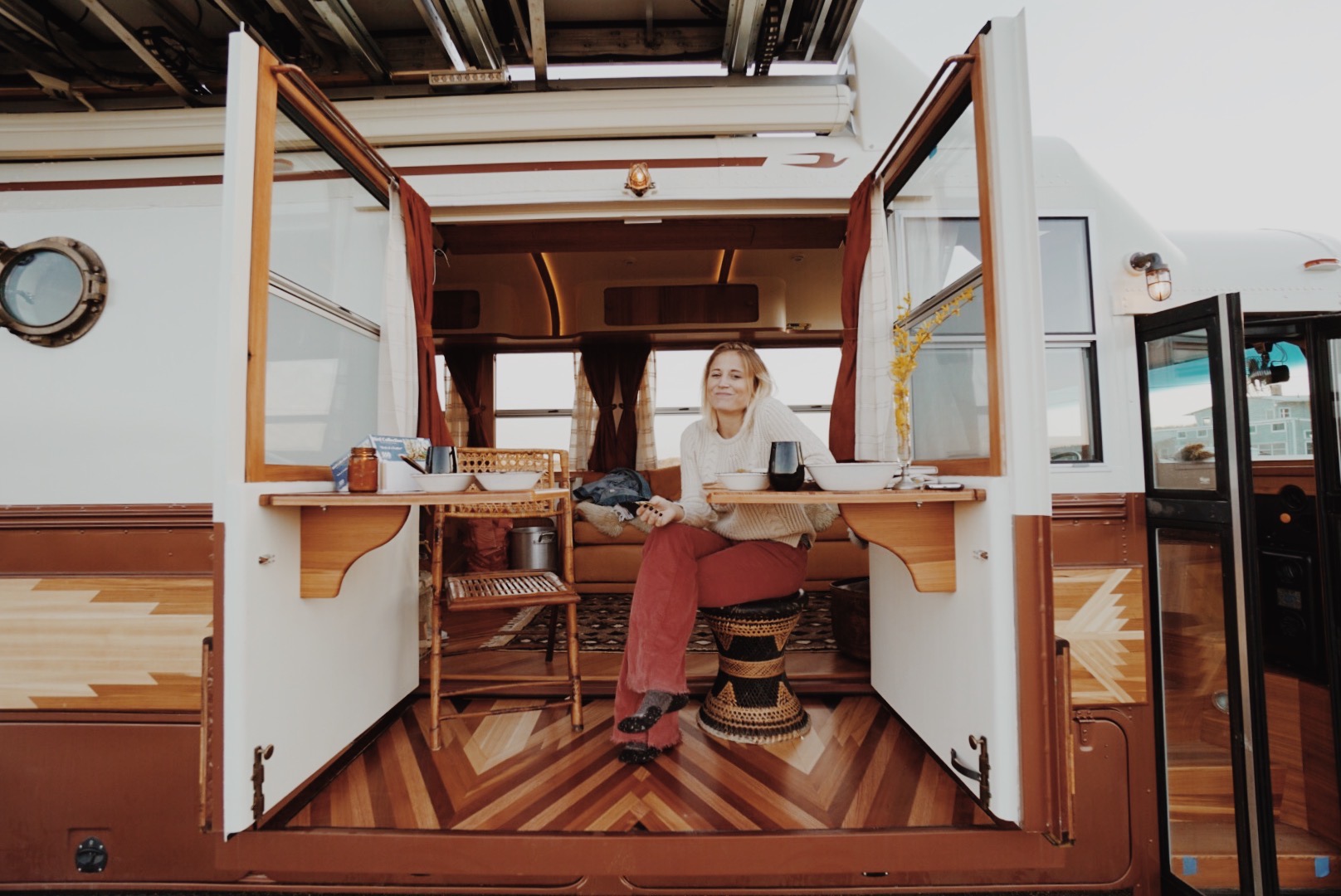
Do you have a background in construction or design?
Construction mainly. In 2009, I started a company with my brother, and we were partners. We bought and sold a lot of homes in California at auctions. We did everything. We would buy them and have construction crews remodel them. We owned the brokerage that marketed and sold them and the whole thing. So we had a whole company going doing that. I had all that experience. Not all of what I learned was applicable to this project ’cause really moving into these kinds of vehicles is a different world. Not a lot of the residential construction applies to this, other than the attitude. You can get it done if you just start and just begin. Just take one little step and the next one will come.
It’s not rocket science, but it is about spending time researching and being a little bit knowledgeable. That background was helpful in relation to plumbing and electrical and how these things all integrate and the order of construction starting with the bones as I was talking about earlier and building out from there is like framing a house and building in. I mean I had that kind of framework to work in, which definitely helped when I was designing it. But I had never designed per se anything like this. Most of the remodeling and things like that were more cookie cutter. They were done on a scale, so it was really simplified. We had a few different paints and a few different carpets, and we kept it simple so that we could process them. But, with this one, I wanted to do something totally the opposite and different and spend my time on something I was passionate about and really get into the design. So, this was my first try at designing every little detail.
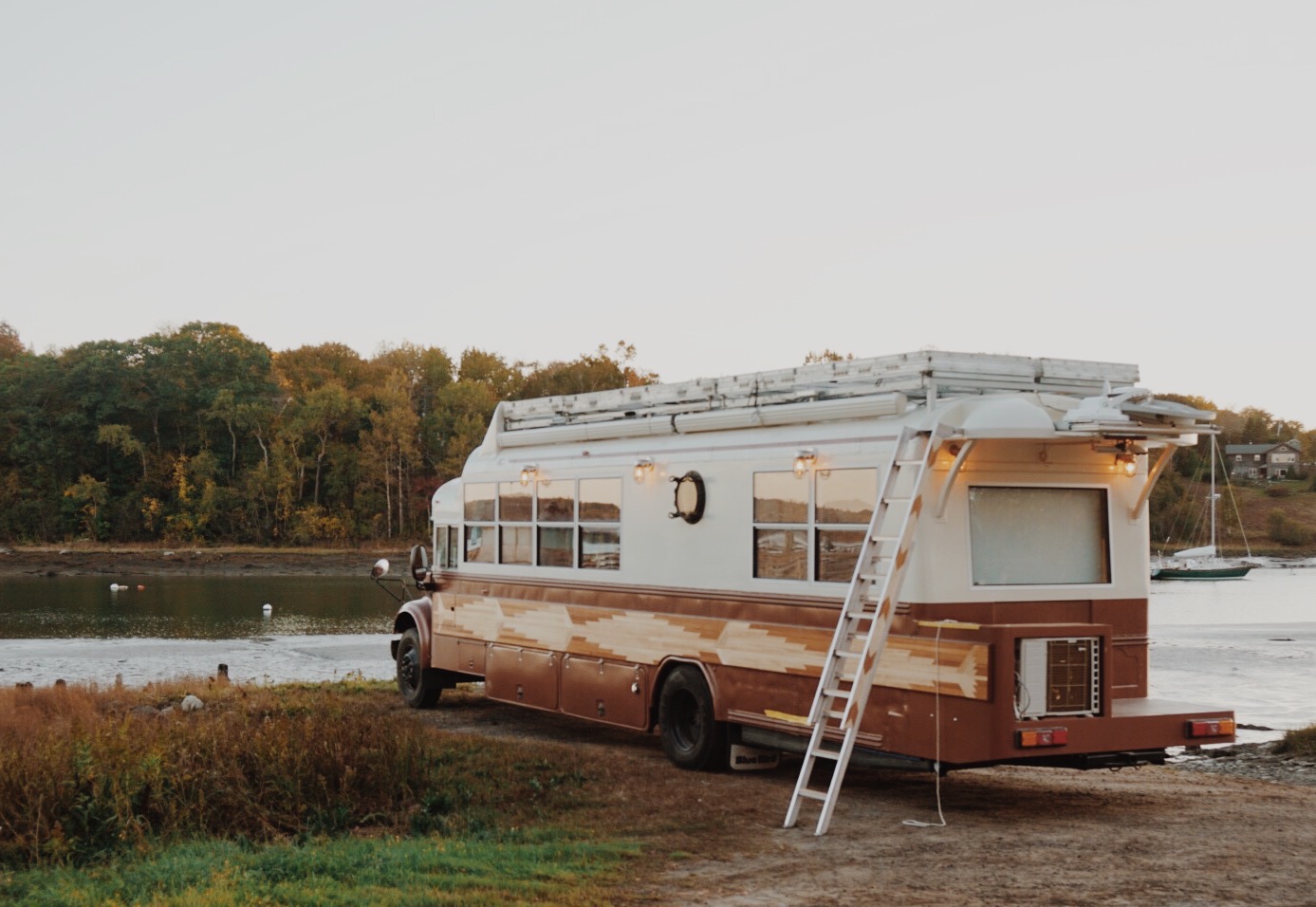
What do you do now that’s gonna allow you to keep working while you drive around? Or are you gonna keep working?
At the moment, I’m in search of my next project. In 2018, once I realized that this bus wasn’t going to be done any time soon, I was waiting because I was like, “I don’t want to pick up some big project and then the bus is done, and now I can’t even move into it because I’ve committed to something.” I was waiting, and then I was like, “Okay this thing isn’t moving.” So, I just did an Airbnb in our hometown which is Fresno, California. I bought this really old house. It was over 100 years old and I completely went down to the studs. It needed it. It was literally one of the worst houses we’ve ever bought in terms of maintenance. The people had completely let it go. It was really, really bad, So, I built it out to finish, and decorated it, and the whole thing.
That was a fun project I did last year in the meantime. And that’s a business, too. That’s an Airbnb. It’s up right now on under The Tower House. I was thinking I was gonna travel around and as we traveled I would find really cool cities that I liked and I’d do more of those Airbnbs. But now that I’ve done that one, I’m thinking I’m gonna probably do something bigger like a motel or a hotel next. I’m kind of focused on national parks, so I’m thinking I’m gonna find a really cool town outside of a national park that has some roadside motel or other place that’s been let go or mismanaged or whatever and take that over and rebuild it from the ground up and give it a different vibe. That’s my next thing. I’m not in a rush, but I’ve got my eye’s peeled for my next big project.
I totally assumed that rich people would see your bus and then you would just end up going into the bus building business.
It’s so funny. I’ve thought about this a million times. Now that I see it, I think there’s something to this. I even met with this really big tour bus company out of Nashville that builds tour buses for rock stars and stuff. They saw the bus, and they were like, “There is a total market for this. You got something special here.” And I was like, “Man, that’s really interesting.” I know it’s cool. I know it’s awesome. But it’s obviously very expensive to build it as I built it. I don’t know if most people want to pay that much because it just takes a lot of man-hours. It’s a ton of man-hours and a lot of details. So I don’t know if everyone wants that exact thing, but I definitely have plans to make more school buses. I’m trying to figure out what that will look like. I’m bouncing between maybe building a few, and then buying land out somewhere really pretty and just parking them on there and letting people stay in them like that.
That’s actually what I was just thinking.
I’m open-minded if I met the right opportunity with it, but I don’t know how much I want to be in the business of owning all these buses and people driving them. I think I’d have to either sell them or leave them still. It’s a lot of moving parts on them.
I just wrote about a bunch of hotels that are filled with Airstream trailers ’cause that’s fairly popular, but an Airstream trailer is much smaller and has many fewer moving parts than your bus obviously does.
Those are awesome. We just stayed at El Cosmico in Marfa
Oh yeah, I wrote about them.
Yeah, they have these awesome old 50’s trailers. I don’t know if any of them are even Airstreams or if they’re just the oldest version of them, but they had all these crazy trailers. That whole trend of the Airstream parks that’s really getting big. They’re much simpler like you’re saying. You don’t have an engine. You don’t have any of that. All the construction doesn’t have to blend with a moving vehicle. You don’t have to deal with the mechanics of it.
The buses you can buy smaller too. They’re kind of similar in a sense, but Airstreams, and I think overall they just build them out in a simpler way ’cause they’re planning on parking them in one location versus my bus is built to be completely self-sufficient and not need to be hooked up to power or water to be able to live in it. So, I think those ones you can build out in a much simpler way.
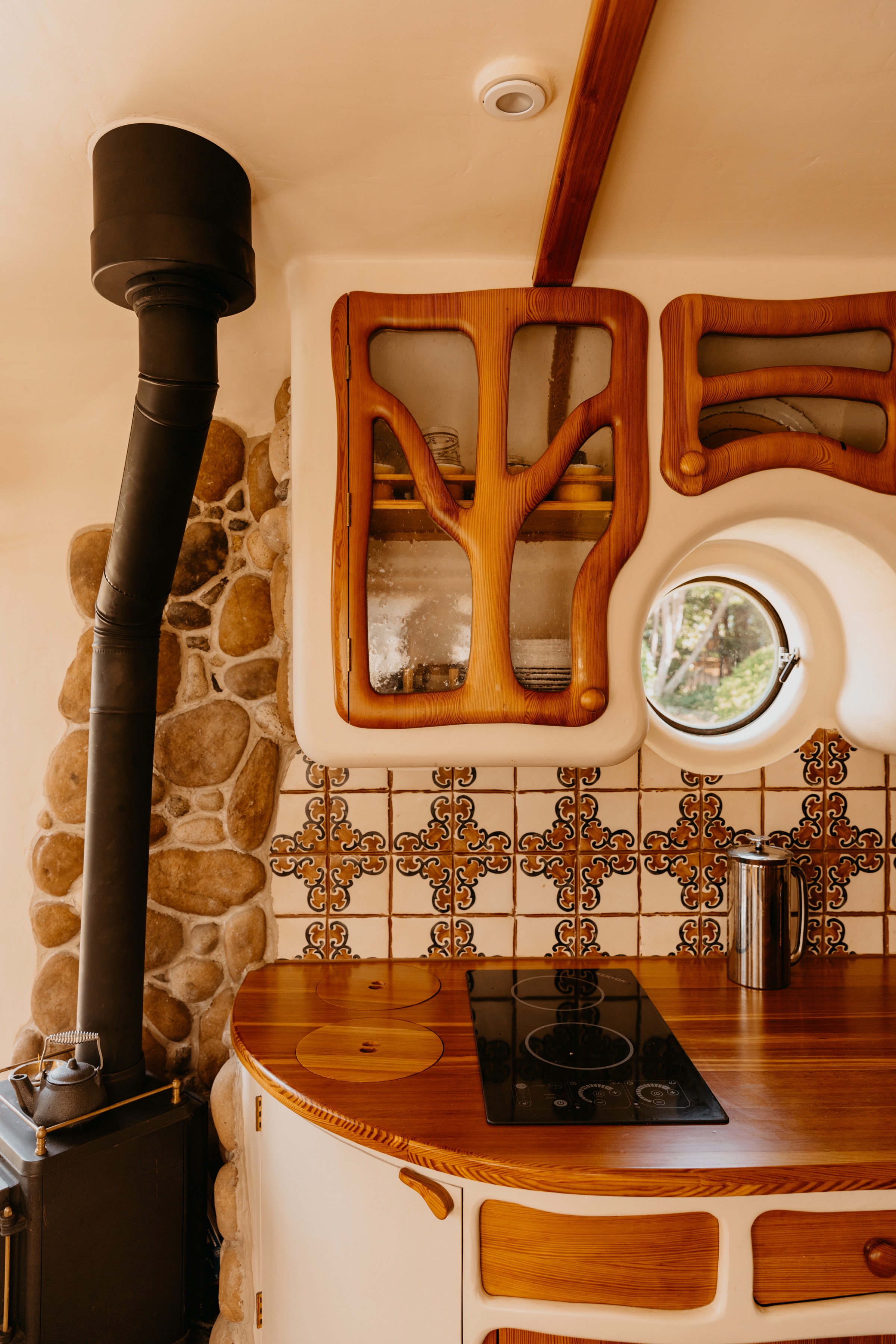
Now that you guys are officially in the bus and moving across the country where are you going?
I’m going towards my dream, which is the whole region from Taos to Mojave, Durango, Monument Valley. There’s this whole patch of earth out there that I keep going back to. And I just wanna finally get to that point where we’re just parked in the middle of nowhere. Nowhere, nowhere like it is out there. The East has places that you can get out and get away from things, but it doesn’t have that same feel as the open West has, and especially out there in southeast Utah or northeast Arizona. It’s just so big and so expansive. That’s where we’re headed.
I think we’ll probably spend a couple weeks in each area, and then as winter comes on maybe spend more time in western Colorado around Silverton and these other ski towns. It’s built for that as well. It has a wood burning stove, and all my water’s insulated, and I have it built out to live through winters which is another thing that most RVs or anything of this type isn’t really built to handle ’cause it’s a lot of extra work to make them usable through a big cold snap under for a long time.
Well, it sounds like you have some fun things ahead. Especially now that the bus is done, I don’t know, I would just think that that would be the most amazing thing ever after you spend two years on something.
I agree. I think we’re just taking it day by day. I’m hoping to go with the wind until that magic happens, and I come across some area that’s just unbelievably beautiful, and I’m like, “This is it.” And then it’s like, “Oh look there’s a spot for sale that matches.” Then, I can stay there for longer and do that project. Another benefit is that we have this mobile home. Essentially, I could pick up a project like that and live in the bus while doing it.
